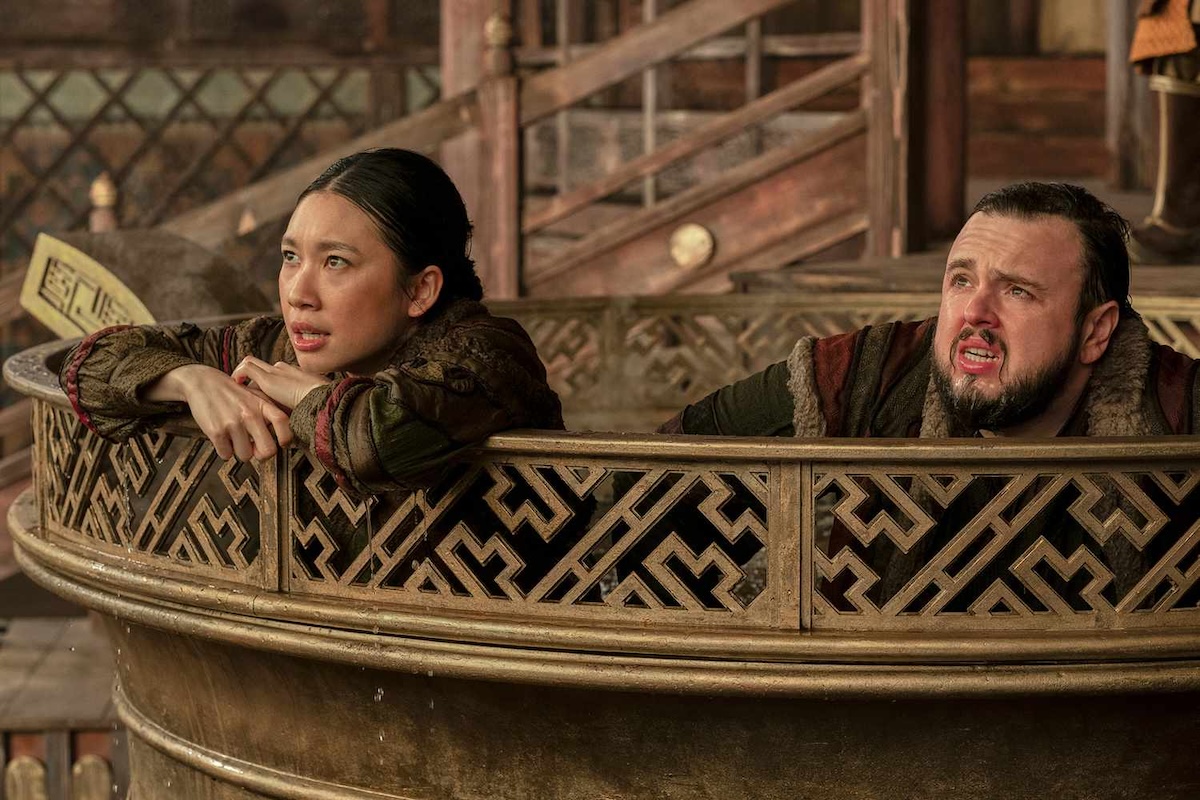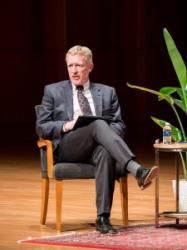My bad. When I was asked to write a review of Netflix’s 3 Body Problem, I assumed we had entered a new stage in the gender wars. Having successfully worked around my undergraduate physical science requirement by taking a January-term class on Einstein and writing a paper on his philosophical ideas, I trust I’m forgiven for not knowing that the “three-body problem” refers to an unsolvable problem in physics. I am informed by the authoritative Wikipedia that the three-body problem takes
the initial positions and velocities (or momenta) of three point masses and solv[es] for their subsequent motion according to Newton’s laws of motion and Newton’s law of universal gravitation. Unlike two-body problems, the three-body problem has no general closed-form solution.
How would Netflix make a show of this, and how might it be of interest to our readers? Or did I just misunderstand?
The series begins promisingly enough—in the past. During a Maoist struggle session, a famous Chinese physicist, Ye Zhetai, is brought before a jeering crowd to recant of sins such as believing that the Big Bang theory is the best explanation for the origin of the universe available and that the science of physics has no definitive answer concerning God’s existence. The crowd, but for one person, his daughter, shout their disapproval, and even his wife takes the stage to denounce him. He is stalwart in his defense of science and subsequently beaten to death for his impertinence.
His daughter, Ye Wenjie, traumatized, turns against the Party, but it recognizes her genius and offers her the opportunity to work in a secret laboratory in the Chinese highlands. There she learns of the government’s efforts to take the lead in interstellar communications. She cleverly figures out a way to intensify and accelerate radio transmissions and receives a reply from beyond: “Do not answer. If you respond, we will come. Your world will be conquered.” Thus begins a fairly conventional alien-invasion science fiction non-thriller, but with enough conceptual material to keep me engaged, even though I dislike the genre.
Ye Wenjie takes the alien threat not as a promise of destruction but of salvation. Disgusted by man’s inhumanity to man, she vows to help the alien race (later revealed as the san-ti) find their new home, as their planet has been rendered uninhabitable by the existence of three suns. We fast-forward to the present and the suicide of Ye Wenjie’s daughter Vera, also a physicist, one trying to make sense of anomalous data produced by the world’s particle accelerators. Confused, she asks one of the defining questions of the series in a conversation with her fellow physicist, the brilliant but undisciplined Saul Durand:
Vera: Do you believe in God?
Saul: Is that what it’s come to? No. I don’t. I accept that this [the anomalies] defies all known laws of physics, but … I don’t think that’s an argument for God.
Vera: So, what’s left?
The underlying theme of the series, though done in a fairly facile way, restates the long-standing conflict between faith and science, and not necessarily to the advantage of science. That conflict brings into relief much condemnation of modernity, not only in terms of exploring the hubristic violation of limits often indulged by science, but also the attendant ecological and political disasters. Our science has not rendered us enlightened but rapacious. Moral progress has not attended material progress; indeed, Ye Wenjie’s experience watching the Red Troops beat her father destroyed any faith she might have had in progress. Reading a purloined copy of Rachel Carson’s Silent Spring in her imprisoned youth convinced Ye Wenjie that humanity exists on this planet as a kind of destructive virus, thus concluding it is “impossible to expect a moral awakening from humankind itself.” Our help must come from above.
While still working with the Chinese government, Ye Wenjie meets the American Mike Evans, a radical environmentalist and scion of an oil magnate, who had dedicated his life to saving an animal species in the Chinese hinterlands. Trying to get Ye Wenjie to desist from building the radio tower on the site where the species lived, he quotes, to Ye Wenjie’s surprise and interest, Rachel Carson: “In nature, nothing exists alone.” Thus begins a fitful romance whereby Evans and Ye Wenjie become co-conspirators in welcoming the san-ti to earth as saviors (the future Evans refers to the voice modulation of the san-ti as “my Lord” and carries around as a holy book the record of his conversations with them), the two of them prophets of the revelation that in the universe nothing exists alone. The show plays with the Fermi paradox: given all the suns that are out there, it seems improbable that there isn’t intelligent life on other planets, so why haven’t we seen it?
But will the san-ti save the human race or destroy it? In a telling conversation, Evans, the only person with a direct line to the san-ti (aboard a ship named Judgement Day), relates the story of Little Red Riding Hood and, to his amazement, discovers how literal-minded the san-ti are. They don’t understand fiction or metaphor, nor do they countenance the wolf’s deception. Their conclusion: “A liar is someone whose words are false. A liar cannot be trusted. We cannot coexist with liars…. We are afraid of you.” At which point, the san-ti cut off connection with Evans, who now, in the fashion of Ingmar Bergman, receives only silence in response to his cries de profundis.
The juxtaposition of a silent, all-knowing, and all-seeing power (as the san-ti have wired themselves into all human communication networks) against the arrogance of science and political revolution forms the arc of the story. In the scientific worldview, human beings have already been reduced to “the ever-changing pattern dancing through the neurons of their brain. If that exists, the person exists.” This conceit allows the san-ti to access brains directly. Faith in the san-tiagainst the promise and limits of scientific knowing places mankind in a tenuous state. No longer confident in our own abilities to perfect the world, either by scientific advancement or political revolution, we become susceptible to the promises of false gods. But what if they’re not false, and what if they judge our imperfection so harshly that they have no choice but to destroy us? Will there be a Noah who can survive the conflagration, with the promise that “if one of us survives, we all survive”?
The series features many characters, most of them two-dimensional, but centers on five young friends who went to university together and are all brilliant scientists. Two of them—Jin Cheng and Jack Rooney—are unwittingly brought by the san-ti into a virtual-reality game that initiates them into the world of the san-ti by running them through the three-body problem and in the process demonstrating their allegiance to the san-ti. When Jack balks at joining the san-ti in their plan, he is summarily dispatched by an alienated woman who possesses unexplained strength. Jin, meanwhile, who seeks “all the big answers” concerning “why the universe works the way it does,” puts together a plan to intercept the san-tiships heading to Earth. Her plan fails. Her friend Will, the most interesting character in the series and dying of cancer, but also in unrequited love with Jin, donates his brain to the project, which now floats endlessly through space.
The only other interesting character is Auggie Salazar, an applied scientist whose created nanofibers are put to deadly use. Horrified by the application of scientific discoveries, she removes herself from the drama and attempts to use her discovery to help people in the Third World. She’ a fairly stock character, but without her the conflict between faith and science lacks its punch. The tension between her and Jin restates the dirty-hands problem: Is it possible to engage in scientific exploration and keep yourself free from any guilt regarding its practical uses? Only Auggie achieves some clarity about that problem, as Jin remains too enthusiastic about “pure” science.
Though still 400 years away from getting to Earth, the san-ti fear the ability of earthlings to advance their technology beyond what the san-ti currently possess. Their immediate goal, therefore, is to kill science with “sophons,” photon-sized artificial intelligence devices that have nearly unlimited capacity. At the denouement, Jin is told by the san-ti with overtones of a malicious demiurge:
We will destroy the science that could defeat us. The answers to your questions will become chaotic and meaningless. The universe will remain a mystery to you forever. In place of truth, we give you miracles. We wrap your world in illusions. We make you see what we want you to see. We are everywhere. Anywhere. Always watching. Learning all your secrets. Uncovering your lies. And we will teach you how to fear again.
The series present the san-ti as a transcendent judge weighing humanity in the balance and finding it wanting. Against the san-ti stands a small group of humanists, using the full force of the remaining science to defeat the san-ti. The most dramatic moment occurs when Ye Wenjie finally learns the truth about the san-ti and their desire to destroy humanity. The full force of what she has done unnerves her, and she prepares to commit suicide, but first she offers her confession. She recalls the death of her father and all that happened on that stage; the Maoist revolutionaries destroying the old order in the belief that doing so would introduce a new and perfect one. She realizes that she has repeated the error:
A man with a hammer smashing the Buddha, Jesus, and a rock and roll record. The slogan said, “Destroy the old world.” “Forge the new world.” It’s the only thing I ever agreed with the Red Guards about.
Between an angry ersatz god who wills their destruction and disillusionment with both science and revolution stands trembling humanity. Going beyond Pascal, the protagonists of 3 Body Problem discover not that the universe is indifferent to their existence but hostile. The san-ti threaten to crush them as bugs (a recurring metaphor). In another echo of Pascal, a character reminds Saul that “bugs don’t know why terrible things happen to them.” Bugs also have a way of surviving all cataclysms, giving the conclusion of season 1 a note of hope. In any case, the fear and trembling have not robbed humans of all their dignity.
What to do? Despair? Worship the san-ti in hopes they might yet change their mind? Fight? Jin accuses Ye Wenjie, who was “willing to risk everything” because she “saw the path we were on” and “where it led,” of having arrogated too much power to herself—to decide for all humanity the road to salvation. “How will you be remembered, Jin Cheng?” “As someone who fought back,” Jin replies.
Season 1 is part of a planned three seasons, so it ends inconclusively. For all its stock characters and no small amount of ham-fisted writing, as well as risible special effects, the series makes an effort to limn the central problems of the human condition: What if the transcendent power is malevolent and not benevolent? What if we fly too close to the sun, transgressing our limits? What if eating of the tree of knowledge brings only death and despair? What happens when, to paraphrase Eric Voegelin, we prefer certain untruths to uncertain truths? Maybe the central lesson is the punchline to a joke told by the Secretary General of the UN to Saul at the end of season 1: “Don’t play with God.” We would do well to drop the “with.”

